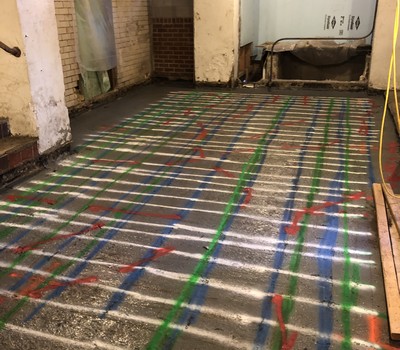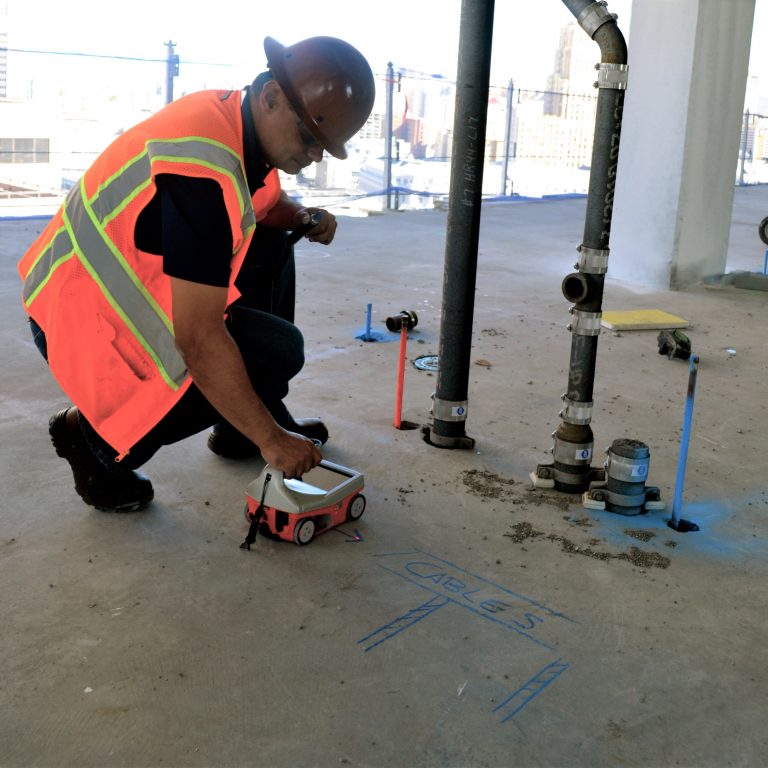The Advantages of RainierGPR Concrete Scanning for Construction Projects
The Advantages of RainierGPR Concrete Scanning for Construction Projects
Blog Article
Maximizing Efficiency and Decreasing Dangers: The Role of Concrete Scanning in Building
In the realm of construction, where accuracy and security are extremely important, the application of concrete scanning technology has actually ended up being an essential tool for task supervisors and designers alike. By utilizing advanced scanning methods, construction groups can navigate intricate atmospheres with increased efficiency while alleviating possible dangers that can endanger both timelines and budget plans. The detailed dance in between maximizing efficiency and reducing dangers in building depend upon the ability to peer underneath the surface area, disclosing a world of hidden challenges and opportunities. The role of concrete scanning in this delicate equilibrium is not simply supportive but transformative, offering a glimpse right into a future where costly errors are preempted, safety and security is focused on, and quality is non-negotiable.

Value of Concrete Scanning
Concrete scanning plays an essential role in making sure the structural stability and safety of building jobs by accurately detecting ingrained items and potential threats within concrete structures. By using various scanning innovations such as ground-penetrating radar (GPR) and electro-magnetic induction, building groups can recognize rebar, post-tension cords, avenues, and various other surprise barriers prior to exploration, cutting, or coring into concrete. This proactive strategy assists protect against costly damages, injuries, and task delays that might emerge from inadvertently striking these items during construction activities.
In addition, concrete scanning help in compliance with security regulations and top quality standards by supplying accurate details about the condition of concrete frameworks. It enables job supervisors and designers to make enlightened choices relating to architectural modifications, repair work, or reinforcements based on reliable information acquired through scanning processes. In addition, the precise mapping of ingrained objects ensures the reliable execution of building strategies, lessening the risk of errors and ensuring the durability and sturdiness of the constructed setting. Eventually, spending in concrete scanning services adds to the overall success and security of building and construction tasks.

Advanced Innovation in Construction
Offered the enhancing demand for accuracy and efficiency in construction methods, the assimilation of innovative innovation has actually come to be important in boosting task outcomes and making sure optimal precaution - RainierGPR Concrete Scanning. One considerable advancement is Structure Information Modeling (BIM), a digital depiction of a building's functional and physical characteristics. BIM allows for far better collaboration among stakeholders, improved visualization of the task, and improved decision-making throughout the building procedure. Furthermore, using drones in construction has revolutionized site studies, progression tracking, and inspections. Drones give real-time information, enhance security by lowering the demand for employees to gain access to high-risk areas, and improve overall job tracking. Moreover, the application of Augmented Reality (AR) and Online Truth (VIRTUAL REALITY) technologies in building layout and drawing board enables stakeholders to imagine the end product, recognize possible issues, and make needed modifications before construction begins. These modern technologies improve procedures, reduce mistakes, and ultimately add to much more reliable and more secure building and construction techniques.

Advantages of Object Mapping
The usage of object mapping innovation in building and construction jobs uses a multitude of advantages that enhance project preparation and execution. Among the essential benefits of object mapping is its capability to give in-depth and precise details concerning the area of below ground energies, architectural aspects, and other objects within the construction site. This information is essential for guaranteeing that excavation and boring tasks are accomplished safely and efficiently, reducing the threat of damage to existing facilities.
Additionally, things mapping innovation makes it possible for building and construction groups to produce accurate 3D models of the website, enabling much better visualization of the job and boosted coordination among various trades - RainierGPR Concrete Scanning. This enhanced spatial recognition helps to recognize prospective clashes and conflicts early in the drawing board, minimizing the demand for costly rework and delays throughout building and construction
Furthermore, item mapping can also improve the documentation process by offering digital documents of the site previously, throughout, and after building. These records offer as beneficial references for future maintenance and remodelling projects, eventually enhancing the long-term performance and sustainability of the built setting.
Stopping Expensive Mistakes
Object mapping modern technology's role in construction extends beyond improving job preparation and implementation to include an essential element: preventing costly errors. By utilizing innovative concrete scanning methods, construction groups can determine prospective dangers such as rebar blockage, post-tension wires, or gaps within concrete frameworks. Discovering these concerns find out early on helps in staying clear of costly errors during the building procedure. As an example, striking a post-tension wire throughout boring can bring about architectural damages, delays, and boosted expenses for repair services. Additionally, precisely mapping out existing utilities underground can avoid unexpected damage during excavation, saving both money and time. In addition, by making use of things mapping modern technology, building groups can guarantee that structure components are set up in the appropriate areas, lowering the probability of rework or retrofitting because of lost components. Overall, the aggressive usage of concrete scanning innovations in building tasks dramatically reduces the risk of mistakes and eventually adds to set you back savings and task effectiveness.
Ensuring Security and High Quality
To promote the greatest criteria of safety and security and high quality in building and construction tasks, the application of concrete scanning modern technology plays a critical function. By making use of innovative scanning techniques such as ground-penetrating radar (GPR) and electromagnetic induction, building groups can detect potential risks concealed within concrete frameworks before commencing any type of work. This proactive strategy not just decreases the risk of crashes on the building site but also ensures the structural stability of the structure.
Concrete scanning additionally assists in validating the positioning of rebar, conduits, and post-tension cable televisions, guaranteeing that these elements are properly placed according to the design specs. This accuracy in finding essential components helps protect against mistakes throughout the construction process, eventually causing a better finished product. Moreover, by determining any kind his response of anomalies or incongruities within the concrete beforehand, necessary modifications can be made without delay, minimizing the possibility of rework and pricey hold-ups.
Fundamentally, concrete scanning innovation functions as a valuable tool in protecting both the safety of construction employees and the overall top quality of the developed setting. Its ability to make sure and spot possible threats adherence to style requirements makes it an essential asset in contemporary building and construction practices.

Verdict
In final thought, concrete scanning my latest blog post plays a vital duty in maximizing efficiency and lessening risks in building and construction projects. By utilizing sophisticated innovation for things mapping, potential pricey blunders can be avoided, making sure safety and top quality of the final framework. It is necessary for building and construction business to prioritize making use of concrete scanning to enhance efficiency, mitigate risks, and deliver high-quality cause their projects.
Concrete scanning plays an essential role in making sure the structural stability and security of construction jobs by accurately discovering embedded objects and possible threats within concrete structures. The application of Increased Reality (AR) and Online Reality (VIRTUAL REALITY) technologies in building and construction style and planning stages enables stakeholders to envision the final product, determine possible issues, and make essential adjustments before building and construction starts. By using sophisticated concrete scanning strategies, construction groups can identify potential risks such as rebar congestion, post-tension cable televisions, or gaps within concrete structures. Generally, the proactive usage of concrete scanning technologies in building jobs significantly lessens the risk of errors and ultimately contributes to cost financial savings and job effectiveness.
To promote the highest criteria of security and quality in building jobs, the implementation of concrete scanning innovation plays a crucial role.
Report this page